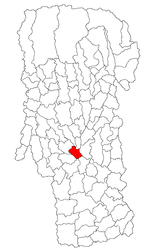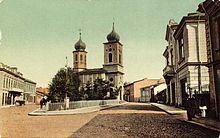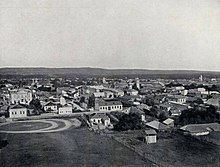
Wallachia or Walachia is a historical and geographical region of modern-day Romania. It is situated north of the Lower Danube and south of the Southern Carpathians. Wallachia was traditionally divided into two sections, Muntenia and Oltenia. Dobruja could sometimes be considered a third section due to its proximity and brief rule over it. Wallachia as a whole is sometimes referred to as Muntenia through identification with the larger of the two traditional sections.

Craiova, is the largest city in southwestern Romania, the seventh largest city in the country and the capital of Dolj County, situated near the east bank of the river Jiu in central Oltenia.

Constantin Brâncoveanu was Prince of Wallachia between 1688 and 1714.

The history of Bucharest covers the time from the early settlements on the locality's territory until its modern existence as a city, capital of Wallachia, and present-day capital of Romania.
Alexandru Paleologu was a Romanian essayist, literary critic, diplomat, and politician. He is the father of historian Theodor Paleologu.

Constantin II Șerban was Prince of Wallachia between 1654 and 1658, illegitimate son to Radu Şerban. According to custom, being born out of wedlock did not disqualify Constantin from becoming prince.

The Saint Sava National College, Bucharest, named after Sabbas the Sanctified, is the oldest and one of the most prestigious high schools in Romania. It was founded in 1694, under the name of the Royal Academy of Bucharest.
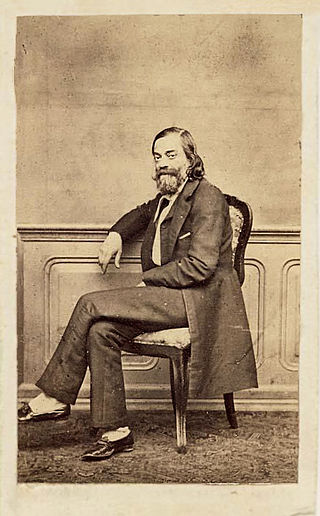
Constantin Alexandru Rosetti was a Romanian literary and political leader, born in Bucharest into the princely Rosetti family.
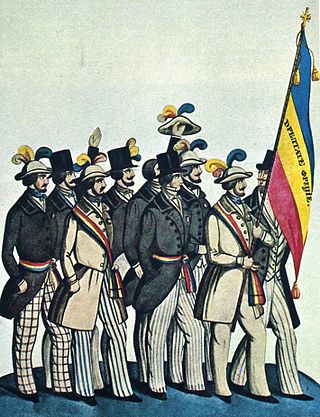
The Wallachian Revolution of 1848 was a Romanian liberal and nationalist uprising in the Principality of Wallachia. Part of the Revolutions of 1848, and closely connected with the unsuccessful revolt in the Principality of Moldavia, it sought to overturn the administration imposed by Imperial Russian authorities under the Regulamentul Organic regime, and, through many of its leaders, demanded the abolition of boyar privilege. Led by a group of young intellectuals and officers in the Wallachian Militia, the movement succeeded in toppling the ruling Prince Gheorghe Bibescu, whom it replaced with a provisional government and a regency, and in passing a series of major progressive reforms, announced in the Proclamation of Islaz.
Constantin Gheorghe Banu was a Romanian writer, journalist and politician, who served as Arts and Religious Affairs Minister in 1922–1923. He is remembered in literary history as the founder of Flacăra review, which he published in two editions, alongside Petre Locusteanu, Ion Pillat, Adrian Maniu, and, later, Vintilă Russu-Șirianu. A best-selling magazine for its time, it functioned as a launching pad for several writers of the Romanian Symbolist movement.

The Paharnic was a historical Romanian rank, one of the non-hereditary positions ascribed to the boyar aristocracy in Moldavia and Wallachia. It was the local equivalent of a cup-bearer or cześnik, originally centered on pouring and obtaining wine for the court of Moldavian and Wallachian Princes. With time, it became a major administrative office and, in Wallachia, also had a lesser military function. The retinue of such boyars, usually called Păhărnicei, was in both countries also a private army.

Emanoil Băleanu, was a Wallachian statesman, soldier and industrialist who served as Caimacam (regent) in October 1858–January 1859. Descending from an old family of boyars, he was one of two sons born to Ban Grigore III Băleanu; the other, Nicolae, was a career bureaucrat, and the State Secretary of Wallachia in 1855–1856. Although prone to displays of Romanian nationalism, the family was prominent under the cosmopolitan Phanariotes, and young Băleanu was educated in Greek. Prince Alexandros Soutzos welcomed him at the court and became his father-in-law. At that stage, Băleanu's participation in the spoils system was signaled by his highly controversial claim to ownership of Târgoviște city, and also by his monopoly on handkerchief manufacture. A slaveowner, he founded the village of Bolintin-Deal, initially populated by his captive Romanies.

Stroe Leurdeanu, also known as Stroe (sin) Fiera, Stroie Leurdeanu, Stroe Leordeanu, or Stroe Golescu, was a Wallachian statesman and political intriguer, son of Logothete Fiera Leudeanu. He began his career with the Wallachian military forces, serving as Spatharios and seeing action in the Polish–Ottoman War of 1633. Related by marriage to the Craiovești dynasty, he emerged as one of the country's most important officials under Prince Matei Basarab: as Vistier, he was in charge of the princely treasury, and also became a regent in 1645. Matei also adopted Stroe's son, Istratie Leurdeanu, but in 1651 turned against the family, and found Stroe guilty of embezzlement. He returned to high favor under a new Prince, Constantin Șerban, who made him his Logothete.

Elisa Brătianu was a Romanian aristocrat, political figure and participant in the Inter-Allied Women's Conference of 1919. She was born into the Stirbey royal family, the daughter of Prince Alexandru B. Știrbei (1837-1895) and the Princess Maria Ghika-Comănești (1851-1885), inheritor of two noble titles, the Ghika family occupying the title of royal family in the history of Romania. An avid gardener, she designed the gardens at the Albatross Villa in Buzău and discussed plans for gardens in Bucharest with the town gardener. Concerned about the loss of traditional Romanian culture, she developed schools to keep stitchery traditions alive and published books of patterns. When her husband, long-serving prime minister Ion I.C. Brătianu died, she spearheaded a foundation to collect his archives and create a library to publish his most important works.

The National College is one of the oldest and most prestigious high schools in Romania, located in Iași, at 4 Arcu Street.
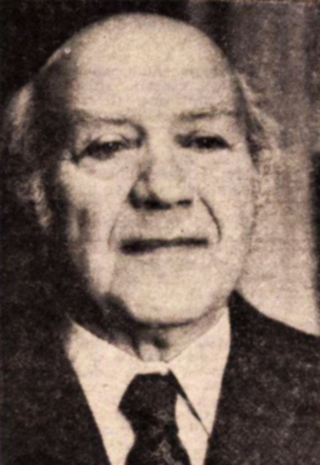
Dan Simonescu was a Romanian literary historian, bibliographer, folklorist, and librarian. His debut was in his late teens, when he accompanied Constantin Rădulescu-Codin during fieldwork in Muscel County, publishing his first contributions in the field of Romanian folklore. After graduating from the University of Bucharest in 1925, and publishing his first book, a collection of articles, in 1926, he became an assistant professor at his alma mater, and was also employed as a librarian by the Romanian Academy. Simonescu joined an editorial team headed by senior scholars Ioan Bianu and Nicolae Cartojan, and, in the 1930s and 1940s, became a major contributor to the collection and publication of old Romanian literature; he was also Cartojan's disciple, though the two disagreed on a parallel project, namely the publication of Mihail Kogălniceanu's collected works, with Simonescu favoring, and eventually putting out, a topical selection of Kogălniceanu's social-themed essays. His own first major contributions were his doctoral thesis, which explored court ceremonials in the Danubian Principalities, and a paper on the emergence of historiography in Early Modern Romania.
Events from the year 1922 in Romania. The year saw the Dealul Spirii Trial and the crowning of King Ferdinand.

The military of Wallachia existed throughout the history of the country. Starting from its founding to 1860, when it was united with the Moldavian army into what would become the Romanian Army.

Scarlat or Scarlatŭ Turnavitu was a Wallachian, later Romanian, schoolteacher, politician, and jurist. He was born into a prosperous family with origins in the high-ranking boyardom, in either his father's village of Budișteni, Muscel County, or in nearby Pitești, Argeș County. During his youth, Wallachia and neighboring Moldavia were Romanian-inhabited tributary states of the Ottoman Empire, with a set of conservative laws imposed in the 1820s, as Regulamentul Organic. Turnavitu and two of his three brothers, Ștefan and Demostene, represented the liberal and nationalist opposition, whose principles they assimilated during their early education in Golești and Bucharest. They endured as lifelong associates of the Golescu family, whose younger members guided their political ascent. During the 1830s and early '40s, Scarlat traveled the country as a reformer, taking charge of primary schools and pioneering teacher education in Giurgiu, Buzău, and finally Craiova.
Events from the year 1881 in Romania. The year saw the end of the United Principalities of Moldavia and Wallachia and the creation of the Kingdom of Romania.




